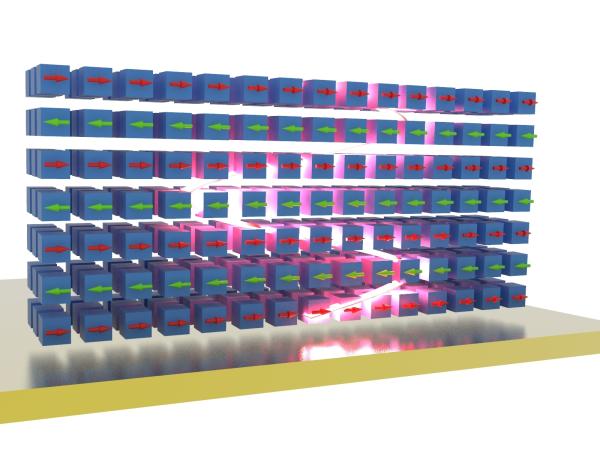
Light trapped inside a magnetic crystal can strongly enhance its magneto-optical interactions. Image created by Rezlind Bushati.
A new study led by Vinod M. Menon and his research group at The City College of New York shows that trapping light inside magnetic materials may dramatically enhance their intrinsic properties. Strong optical responses of magnets are important for the development of magnetic lasers and magneto-optical memory devices, as well as for emerging quantum transduction applications.
In their new article in the journal "Nature," Menon and his team report the properties of a layered magnet that hosts strongly bound excitons -- quasiparticles with particularly strong optical interactions. Because of that, the material is capable of trapping light -- all by itself. As their experiments show, the optical responses of this material to magnetic phenomena are orders of magnitude stronger than those in typical magnets. "Since the light bounces back and forth inside the magnet, interactions are genuinely enhanced," said Dr. Florian Dirnberger, the lead-author of the study. "To give an example, when we apply an external magnetic field the near-infrared reflection of light is altered so much, the material basically changes its color. That's a pretty strong magneto-optic response."
"Ordinarily, light does not respond so strongly to magnetism," said Menon. "This is why technological applications based on magneto-optic effects often require the implementation of sensitive optical detection schemes.”
On how the advances can benefit ordinary people, study co-author Jiamin Quan said: “Technological applications of magnetic materials today are mostly related to magneto-electric phenomena. Given such strong interactions between magnetism and light, we can now hope to one day create magnetic lasers and may reconsider old concepts of optically controlled magnetic memory." Rezlind Bushati, a graduate student in the Menon group, also contributed to the experimental work.
The study conducted in close collaboration with Andrea Alù and his group at CUNY Advanced Science Research Center is the result of a major international collaboration. Experiments conducted at CCNY and ASRC were complemented by measurements taken at the University of Washington in the group of Prof. Xiaodong Xu by Dr. Geoffrey Diederich. Theoretical support was provided by Dr. Akashdeep Kamra and Prof. Francisco J. Garcia-Vidal from the Universidad Autónoma de Madrid and Dr. Matthias Florian from the University of Michigan. The materials were grown by Prof. Zdenek Sofer and Kseniia Mosina at the UCT Prague and the project was further supported by Dr. Julian Klein at MIT. The work at CCNY was supported through the US Air Force Office of Scientific Research, the National Science Foundation (NSF) – Division of Materials Research, the NSF CREST IDEALS center, DARPA and the German Research Foundation.
About The City College of New York
Since 1847, The City College of New York has provided a high-quality and affordable education to generations of New Yorkers in a wide variety of disciplines. CCNY embraces its position at the forefront of social change. It is ranked #1 by the Harvard-based Opportunity Insights out of 369 selective public colleges in the United States on the overall mobility index. This measure reflects both access and outcomes, representing the likelihood that a student at CCNY can move up two or more income quintiles. Education research organization Degree Choices ranks CCNY #1 nationally among universities for economic return on investment. In addition, the Center for World University Rankings places CCNY in the top 1.8% of universities worldwide in terms of academic excellence. Labor analytics firm Emsi puts at $1.9 billion CCNY’s annual economic impact on the regional economy (5 boroughs and 5 adjacent counties) and quantifies the “for dollar” return on investment to students, taxpayers and society. At City College, more than 15,000 students pursue undergraduate and graduate degrees in eight schools and divisions, driven by significant funded research, creativity and scholarship. This year, CCNY launched its most expansive fundraising campaign, ever. The campaign, titled “Doing Remarkable Things Together” seeks to bring the College’s Foundation to more than $1 billion in total assets in support of the College mission. CCNY is as diverse, dynamic and visionary as New York City itself. View CCNY Media Kit.
Jay Mwamba
p: 917.892.0374
e:
jmwamba@ccny.cuny.edu